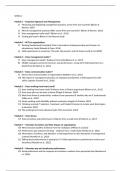Syllabus:
Module 1 – Empirical Approach and Management
1) Measuring and Explaining management practices across firms and countries (Bloom &
Reenen, 2007)
2) Why do management practices differ across firms and countries? (Bloom & Reenen, 2010)
3) Does management really work? (Bloom et al., 2012)
4) Scoring grid used in Bloom & Van Reenen study
Module 2 – RCTs in organizations
5) Running Randomised Controlled Trials in Innovation, Entrepreneurship and Groups: An
introductory Guide (Edovald & Firpo, 2016)
6) Field experiments in economics: The past, the present, and the future Levitt & List (2009)
Module 3 – Does management matter?
7) Does management matter? Evidence from India (Bloom et al., 2013)
8) Middle managers, personnel turnover, and performance: a long-term field experiment in a
Retail Chain (Friebel et al., 2012)
Module 4 – Does communication matter?
9) Face-to-face communication in organizations (Battiston et al., 2021)
10) The impact of management practices on employee productivity: a field experiment with
airline captains (Gosnell et al., 2020)
Module 5 – Does working from home work?
11) Does working from home work? Evidence from a Chinese experiment (Bloom et al., 2015)
12) How many jobs can be done at home (Dingel & Neiman, 2020)
13) Work from home & productivity: evidence from personnel & analytic data on IT professionals
(Gibbs et al., 2023)
14) Smart working: work flexibility without constraints (Angelici & Profeta, 2023)
15) ‘Working remotely?’ Selection, Treatment, and Market Provision of remote work (Harrington
& Emanuel, 2023)
16) The working-from-home delusion fades (The economist, 2023)
Module 6 – Team bonus
17) Team incentives and performance: Evidence from a retail chain (Friebel et al., 2017)
Module 7 – Monetary incentives and their impact on organizations
18) When bonuses backfire: Evidence from the workplace (Alfitian et al.2023)
19) Performance pay and prior learning – evidence from a retail chain (Mathei et al., 2021)
20) Information, incentives, and attention: a field experiment on the interaction of management
controls (Manthei et al., 2022)
21) Talking about performance or paying for it? A field experiment on performance reviews and
incentives (Manthei et al., 2022)
Module 8 – Monetary pay and employees performance
22) Social preferences and the response to incentives: evidence from personnel data (Bandiera et
al., 2005)
, 23) Incentives for managers and inequality among workers: evidence from a firm-level
experiment (Bandiera et al., 2007)
Module 9 – Non-monetary practices and their impact on employees
24) Effects of supportive leadership behaviours on employee satisfaction, engagement and
performance: an experimental field investigation (Haeckl & Rege, 2022)
25) What do workplace wellness programs do? Evidence from Illinois workplace wellness study
(Jones et al., 2020)
,Module 1 – Empirical approach and management
1.Measuring and Explaining management practices across firms and countries (Bloom & Reenen,
2007)
Bloom and Van Reenen (2007) study survey data to evaluate whether differences in the use of
management practices can explain productivity differences between firms.
Outcomes:
- Management practices display significant cross-country differences.
- Management practices show even bigger within-country variations.
What could rationalize such variations in management practices?
- (Lack of) competition: creates incentive to reduce inefficiencies and kills off badly managed
firms
- Family firms: due to limited selection into managerial positions (primogeniture) these tend to
be very badly managed.
2.Why do management practices differ across firms and countries? (Bloom & Reenen, 2010)
They used an interview-based evaluation tool to assess 18 basic management practices. Interviewers
give a score from 1-5 on the 18 practices, a scoring grid is used (see document (4)).
Outcomes:
- Core management practices can’t be taken for granted, there are large differences in
management practices.
- Firms with strong managerial processes perform significantly better on productivity,
profitability, growth and longevity.
- The differences in the quality of those processes – and in performance – persist over time,
suggesting that competent management is not easy to replicate.
3.Does management really work? (Bloom et al., 2012)
Three key areas of management practices:
1) Monitoring: monitor what goes on inside the firm, use for continuous improvement.
2) Targets: set the right targets, track the right outcome and take appropriate action if not.
3) Incentives: promoting and rewarding employees based on performance
Management practices matter: there is a solid empirical evidence that good management practices
correlate with higher productivity, survival rate, higher profits, faster growth. But this effect can not
be taken as causal.
False perception: managers’ self-assessments are far away from reality. Overconfidence is a problem
for managers. The authors explained these results by:
- False beliefs of managers who really need to improve
- But also, managers may overestimate the costs and/or underestimate the value of good
management
, Statistical method: OLS regression
Interpretation of functional forms:
Correlation does not mean causality. Regression analysis is not a, since a statistical relationship
doesn’t guarantee a causal relationship between dependent and independent variables. There can be
omitted variables and/or reversed causality.
With experiments, RCTs, we can observe if a relationship is causal, see next module.




